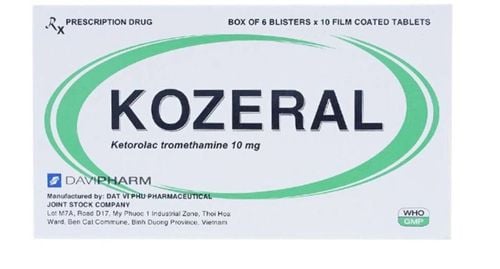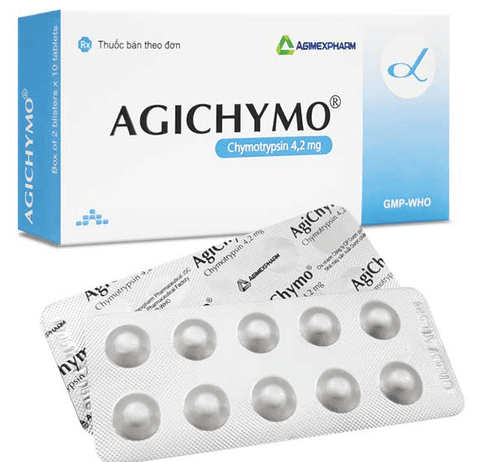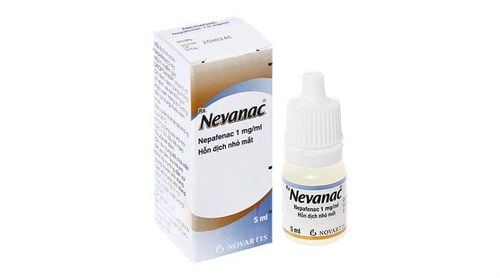This is an automatically translated article.
Etonsaid 10 is prepared in the form of dispersible tablets, with the main ingredient being Ketorolac tromethamine 10mg. The drug is used to treat pain after surgery. Let's learn about Etonsaid 10 drug information through the article below.
1. What is Etonsaid 10?
The Ketorolac ingredient in Etonsaid 10 has the same chemical structure as indomethacin and tolmetin, belongs to the group of non-steroidal anti-inflammatory drugs, inhibits the synthesis of prostaglandins - a mediator that causes inflammation, fever, and pain. Since then, the drug has analgesic, anti-inflammatory and antipyretic effects, but the analgesic effect is greater than anti-inflammatory, and is used as an alternative to opioids and non-steroidal analgesics in the treatment of moderate to severe pain after surgery. , in addition can be used in the treatment of musculoskeletal pain or other pain. However, Ketorolac does not cause addiction or respiratory depression like other opioids.2. What does Etonsaid 10 do?
Etonsaid 10 is used to replace opioid preparations in the short-term treatment of moderate to severe pain after surgery.
Do not use Etonsaid 10 in the following cases:
People with hypersensitivity to ketorolac or other non-steroidal anti-inflammatory drugs Prophylactic analgesic during surgery or during labor History of peptic ulcer or bleeding digestion People with a history of coagulopathy, taking anticoagulants Angioedema or bronchospasm Volume depletion due to dehydration or any cause People with moderate to severe renal impairment Pregnant or are breast-feeding Safety and effectiveness have not been established in children under 16 years of age, and therefore should not be used in this age group.
3. Dosage and how to use Etonsaid 10
3.1. Dosage The drug dose depends on each subject:
People aged 16 - 64 years, weight > 50 kg, normal kidney function: starting dose of 20mg, followed by 10mg/time every 4-6 hours /times if needed. People over 65 years old or under 50kg and/or with impaired kidney function: 10mg/time, every 4-6 hours if needed. The maximum dose should not exceed 40mg/day. 3.2. How to take the drug Take the drug with food to reduce stomach irritation, the first 2 doses can be taken on an empty stomach for a quick effect or used in combination with antacids. Take the medicine with a full glass of water, after taking keep the person in an upright position for 15 - 30 minutes to reduce the risk of esophageal irritation. The drug should not be used for more than 5 days.
4. Side effects of Etonsaid 10
When using Etonsaid 10 may experience some undesirable effects as follows:
Body as a whole: anaphylaxis, headache, dizziness, edema, depression Central nervous system: Fatigue, depression / agitation , difficulty concentrating, insomnia, paresthesia, sweating. Gastrointestinal: Nausea, vomiting, dyspepsia, abdominal pain, diarrhea/constipation, dry mouth, change in taste, peptic ulcer, gastrointestinal bleeding. Itching, urticaria, skin rash. Asthma, difficulty breathing. Oliguria, urinary retention, impaired renal function Visual disturbances. When using Etonsaid 10, if the patient experiences any serious side effects, stop taking the drug and contact the treating doctor or go to a medical facility for timely treatment.
5. Interaction with Etonsaid 10
When using Etonsaid 10 in combination, there may be interactions with some of the following drugs:
Concomitant use with Aspirin increases the risk of unwanted effects. Diuretics Furosemide, thiazides: reduce sodium diuretic effect Anticoagulants: increase risk of gastrointestinal bleeding. Combination with ACE inhibitors or angiotensin 2 receptor blockers increases the risk of renal failure and reduces the antihypertensive effect of the drug. Concomitant use of probenecid increases the concentration and half-life of ketorolac. Lithium: decreased renal clearance of lithium, increased blood levels of lithium Increased toxicity in combination with methotrexate.
6. Notes and cautions when using Etonsaid 10
When using Etonsaid 10, it is necessary to be cautious of the following issues:
Do not use ketorolac with corticosteroids, aspirin or other non-steroidal anti-inflammatory drugs at the same time because it may increase the risk of stomach ulcers, gastrointestinal bleeding. Use with caution in the elderly because the drug is eliminated slowly and is more sensitive to nephrotoxic and harmful effects on the gastrointestinal tract. Be careful with people with impaired liver and kidney function, reduce the dose when necessary. Do not use in late pregnancy due to the risk of premature closure of the ductus arteriosus. If symptoms of dizziness, headache, drowsiness appear, caution should be exercised when driving, operating machinery or doing work that requires concentration and alertness. In addition to the above information, if you have any questions about Etonsaid 10, you can contact your doctor for advice and answers.













